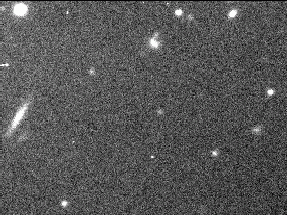Satellite-hunters find four new moons of the planet Saturn
By David Brand
An international team of eight "satellite hunters," astronomers who pluck tiny specks of light out of the distant solar system, has discovered four new outer moons of Saturn orbiting at least 15 million kilometers (more than 9 million miles) from the surface of the giant planet.
The discovery gives Saturn a total of 22 known moons, surpassing the 21 orbiting Uranus. Nothing is known about the four new moons except for their brightness. Estimates of their size – between 10 and 50 kilometers (6-30 miles) across – are based on assumptions of their reflectivity. Observed from Earth-bound observatories, the moons appear as faint dots of light moving around the planet.
Members of the team, including former Cornell University researcher Brett Gladman and Cornell professors of astronomy Joseph Burns and Philip Nicholson, warn that the findings are still preliminary. They also note that they might have discovered several other objects that could be Saturnian moons.
The discovery of the four moons will be reported today (Oct. 26, 2000) at the annual meeting of the Division for Planetary Sciences, American Astronomical Society, in Pasadena, Calif. Other members of the team include Jean-Marc Petit and Hans Scholl of the Observatoire de la Cote d'Azur, France; J.J. Kavelaars of McMaster University, Canada; and Matthew Holman and Brian Marsden of the Harvard-Smithsonian Center for Astrophysics.
The discovery of the four new moons was made using a technique developed by Gladman while he was a student at Cornell. Gladman, who now works for the Centre National de la Recherche Scientifique in France, obtained his Ph.D. at Cornell. The technique, which also was used in the discovery of the five new Uranian moons, uses light-sensitive semiconductors, called charge-coupled devices, attached to telescopes to detect the distant points of light. Several of these digital images, taken once every hour, are then compared, using computer software to pick out a moving point of light against the known star background of the sky.
Between 1997 and 1999, the same team discovered a total of five new moons of Uranus. All five, like the newly discovered four outer moons of Saturn, are irregular satellites. Burns notes that an irregular satellite's orbit is "long and looping," unlike the orbit of an inner moon, which is nearly circular and lies in the planet's equatorial plane.
The great distance that the moons orbit from Saturn, says Nicholson, indicates that the moons were captured into orbit after the planet formed, unlike the larger regular satellites that are thought to have coalesced from a disk of dust and gas that surrounded the planet as it formed.
Until this latest discovery, Saturn was known to have only one irregular, outer satellite, Phoebe, which was discovered by W. Pickering 102 years ago. Nicholson notes that Phoebe is traveling in a retrograde orbit, that is, in the opposite direction to the spin of Saturn. All regular satellites move on prograde orbits that follow the direction of the spin of their parent planet. "We look for such patterns because it's easier to capture objects from a solar orbit into a retrograde than onto a prograde orbit," says Nicholson. "If you could demonstrate statistically that retrograde orbits were favored, that would help confirm some theories of capture."
The first two candidates for newly discovered satellites of Saturn were spotted by Gladman using the European Southern Observatory's 2.2 meter telescope in Chile on Aug. 7. Gladman and Kavelaars "recovered" the two objects Sept 23 and 24 at the Canada-France-Hawaii 3.5 meter telescope on Mauna Kea, Hawaii. They also found two new candidates. Additional confirming observations were made at other telescopes.
Media Contact
Get Cornell news delivered right to your inbox.
Subscribe